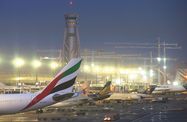The emirate’s aviation authorities have floated a proposal to expand what is already one of the busiest airports in the world, looking to double the planned capacity of Dubai International Airport (DXB) as part of what could be a major shift in government policy.
At the end of March, Dubai Airports, the operator of the emirate’s two airports, announced it was preparing a proposal to increase DXB’s passenger-handling capacity from the 100m it is expected to reach by 2020 to 200m by 2045. Current capacity at the airport is around 75m passengers per year.
DXB is already seeing demand for flight slots rising, and passenger numbers continue to grow strongly. The hub handled 57.7m passengers in 2012, making it the fourth-busiest airport in the world in terms of international traffic, and the 10th-busiest in terms of total traffic. Authorities expect passenger numbers to rise to 65.4m in 2013, with DXB surpassing Hong Kong and France’s Charles de Gaulle in early 2013 and projected to overtake London’s Heathrow as the busiest airport worldwide for international traffic by 2015.
The 2013 projections seem well within reach. As of the end of the first quarter, the facility had handled just under 16.5m passengers, up 15.6% on the same three-month period in 2012, with March seeing 5.8m visitors pass through the terminals, a 20.6% increase year-on-year, according to figures released in late April.
This rapid increase in traffic has prompted a review of Dubai’s medium-term plans for the sector. According to Suzanne Al Anani, the CEO of Dubai Aviation Engineering Projects – the agency tasked with developing the emirate’s aviation infrastructure – the strategic plan for the sector, first unveiled in 2010 and due to run though to 2020, is being overtaken by the rapid pace of growth. “The 2020 plan is almost outdated,” Al Anani said in an interview with MEED Media. “We are currently finalising a major sensitive study on Strategic Plan 2045 and we are preparing for a major presentation to the aviation sector board in May.”
A decision on that direction could have a major impact on one of the emirate’s headline development projects, the Al Maktoum International Airport (AMIA), the cornerstone of the Dubai World Central transport industry and logistics centre. The airport is already operational as an aviation cargo centre. As planned, AMIA is to have a cargo-moving capacity of 12m tonnes annually, along with the facilities to handle 160m passengers. In early April 2013, Dubai Airports announced that AMIA would begin serving passenger flights as of the end of October. Saudi carrier nasair and Hungarian low-cost airline WizzAir are planning to operate over 50 flights a week from the airport.
If the government supports the proposal to double the capacity of DXB to 200m, this could result in a scaling back of the original passenger plans for AMIA. While Dubai will likely become the world’s leading hub for international passenger traffic in the next few years, it may not need the combined annual capacity of more than 360m that an extended DXB and a fully operational AMIA would offer.
Currently, AMIA has a passenger throughput capacity of around 7m per year, though the next stage of expansion is set to increase this to 80m, half the final planned total. However, the final completion date for the project was put back to the middle of the next decade following the onset of the global financial crisis in 2008. If the continued expansion of DXB goes ahead, this may signal a shift away from plans to make AMIA the emirate’s main aviation hub, although its role as the centrepiece of the aero industry and logistics complex is likely to remain intact.
The aviation sector is already one of the leading contributors to the local economy, with direct and indirect input estimated to be more than 20% of Dubai’s GDP, a figure that is expected to rise to around 32% by 2020, according to a 2011 report by Oxford Economics. Further developments, such as those proposed for the two airports and their supporting segments, could see this pushed higher by the middle of the century.
While the proposals for expanding DXB are to be presented to the government in May, it will likely be some time before it is clear which route will be taken, be it further developing the existing main hub, pushing ahead with AMIA as the new focus or a possible mix of the two. However, DXB’s growing status and popularity make a strong argument for expansion and continuity, with its younger sibling well-placed to extend its role as the region’s leading freight hub as well as to ease some of the pressure on DXB.

